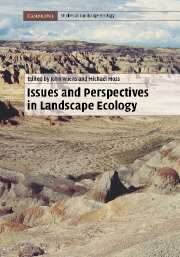Book contents
- Frontmatter
- Contents
- List of contributors
- Preface
- PART I Introductory perspectives
- 1 When is a landscape perspective important?
- 2 Incorporating geographical (biophysical) principles in studies of landscape systems
- PART II Theory, experiments, and models in landscape ecology
- PART III Landscape patterns
- PART IV Landscape dynamics on multiple scales
- PART V Applications of landscape ecology
- PART VI Cultural perspectives and landscape planning
- PART VII Retrospect and prospect
- Index
- Plate section
- References
1 - When is a landscape perspective important?
from PART I - Introductory perspectives
Published online by Cambridge University Press: 20 November 2009
- Frontmatter
- Contents
- List of contributors
- Preface
- PART I Introductory perspectives
- 1 When is a landscape perspective important?
- 2 Incorporating geographical (biophysical) principles in studies of landscape systems
- PART II Theory, experiments, and models in landscape ecology
- PART III Landscape patterns
- PART IV Landscape dynamics on multiple scales
- PART V Applications of landscape ecology
- PART VI Cultural perspectives and landscape planning
- PART VII Retrospect and prospect
- Index
- Plate section
- References
Summary
What is landscape ecology?
Although the definition of landscape ecology has been dealt with extensively (some would say ad nauseam) in the landscape ecological literature, there remains confusion among other ecologists as to exactly what landscape ecology is and, particularly, what its unique contribution is to ecology as a whole.
Ecology is the study of the interrelationships between organisms and their environment (Ricklefs, 1979). The goal of ecological research is to understand how the environment, including biotic and abiotic patterns and processes, affects the abundance and distribution of organisms (Fig. 1.1). This includes indirect effects such as the effect of an abiotic process (e.g., fire) on a biotic process (e.g., germination), which in turn affects the abundance and/or distribution of an organism. Processes considered are typically at a “local” scale, that is, at the same scale or smaller than the scale of the abundance/distribution pattern of interest.
Landscape ecology, a subdiscipline of ecology, is the study of how landscape structure affects the abundance and distribution of organisms (Fig. 1.2). Landscape ecology has also been defined as the study of the effect of pattern on process (Turner, 1989), where “pattern” refers specifically to landscape structure. The full definition of landscape ecology is, then, the study of how landscape structure affects (the processes that determine) the abundance and distribution of organisms. In statistical parlance, the “response” variables in landscape ecology are abundance/distribution/process variables, and the “predictors” are variables that describe landscape structure.
- Type
- Chapter
- Information
- Issues and Perspectives in Landscape Ecology , pp. 3 - 10Publisher: Cambridge University PressPrint publication year: 2005
References
- 42
- Cited by



